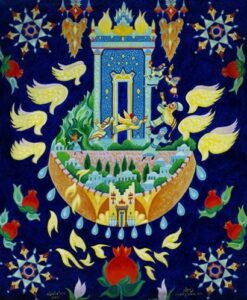בס”ד
By Rabbi Moshe Goodman, Kollel Ohr Shlomo, Hebron

This parsha discusses the Mishkan, the forerunner of the Beit Hamikdash, which takes the primary focus
in this painting. We see seven yellow pairs of wings hinting to the angelic holy status of the Temple. We
see seven dancing hasidim and seven pomegranates, seven being the special Jewish number that appears
in many of R’ Nachshon’s paintings. Of the seven hasidim five are also playing instruments. This may hint
to a Kabbalisic division which places the five sefirot from hesed to hod in one category, while yesod and
malchut are considered to “receive” from the five sefirot hesed till hod. Therefore, this may explain why
two hasidim are only dancing, as if dancing to the music of the other five, I.e “receiving” their signal. Of
the five playing instruments, the top two may hint to hesed and gevura, considered the “source”, I.e “on
top” of the other five sefirot below them. The hasid enrobed with a distinguished talis may hint to tiferet,
since the Arizal says that the talis has a numerical value of 45 times ten, and the number 45 is a number
associated to tiferet, according to the Kabbalists. Next to this hasid is a “flying” hasid, apparently
emphasizing his agility and movement, a matter that can be attached to the sefira of netzach, which is
associated with movement. One hasid is playing a percussion instrument which apparently hints to hod, a
sefira assocaited with the feminine, and women are described as playing percussion instruments in the
song of Miriam.
We see twelve yellow leaves/flames ascending to the Temple, apparently hinting to the twelve tribes
ascending to the Temple in pilgrimage. This highlights the uniting peaceful force of the Temple upon
which it is said “there the tribes of God ascend” and “seek the peace of Jerusalem.” This matter may
explain why Hebron can be seen as a forerunner towards Jerusalem, as we see that King David first ruled
in Hebron and then in Jerusalem. Indeed, as its name indicates, Hebron also stands for unity. Through it
King David united all Israel under one kingdom, and through it he raised them towards the Beit
Hamikdash, uniting all Israel before the One God.



